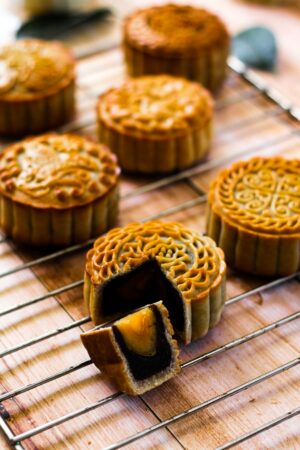

Ambrose Mong
Celebrated on the 15th day of the eighth lunar month, the Mid-Autumn Festival [中秋節] is one of the most significant cultural celebrations in China and other Southeast Asian societies—second only to the Spring Festival. In Singapore, we call it “Mooncake Festival” because we do not have autumn or rather, the four seasons.
Mid-autumn festival traditions
The earliest record of the Mid-Autumn Festival appears in the Book of Rites. It began as a ritual rooted in agricultural civilisation— a form of folk moon worship. Over time, it evolved into a celebration of the harvest, and later became a tradition for praying to the moon deity for abundance in the coming year and a stable, peaceful life.
The day of the festival is calculated to coincide with the roundest and brightest moon of the year. This fullness symbolises completeness, unity, and good fortune for the family and home. Admiring the full moon, family members and friends gather for a meal and the sharing of mooncakes [月餅].
As Christians, the moon can symbolise God’s perfection, faithfulness and the light of Christ shining in the darkness
While not a religious ritual, the Mid-Autumn Festival carries deep cultural and spiritual meaning. In many ways, it resembles Western Thanksgiving—a heartfelt occasion for reunion, gratitude, and hope. Now the celebration, like Christmas, has become increasingly commercialised and secularised.
Christians and the moon
For Chinese Christians, the Mid-Autumn Festival does not pose a theological conflict, but rather, an opportunity for reflection in the context of our cultural identity. Thus, for the majority of people, it is not a religious ritual, but a family reunion [團圓], gratitude, and celebration of the year’s blessings. Some churches in Taiwan, Hong Kong, and Singapore organise gatherings to host their own ‘Mid-Autumn Fellowship Nights’, blending cultural tradition with Christian fellowship.
As Christians, the moon can symbolise God’s perfection, faithfulness and the light of Christ shining in the darkness. Reuniting with our families and friends reminds us that we are part of God’s big family. We thank him as the giver of hope in this life and in the afterlife.
As part of the inculturation of our faith, the Church has encouraged Catholics to celebrate the positive aspects of this cultural heritage, especially those related to family, by directing our worship and thanksgiving to God.
…the Mid-Autumn Festival carries deep cultural and spiritual meaning. In many ways, it resembles Western Thanksgiving—a heartfelt occasion for reunion, gratitude, and hope
The moon in the Bible
In the scriptures, the moon carries symbolic meaning related to God’s creation, the passage of time, and eschatology or the end times. In the Old Testament, the moon is presented as part of God’s creation for a specific purpose:
Genesis 1:14 -18: “And God said, ‘Let there be lights in the dome of the sky to separate the day from the night; and let them be for signs and for seasons and for days and years, and let them be lights in the dome of the sky to give light upon the earth.’
“And it was so. God made the two great lights—the greater light to rule the day and the lesser light to rule the night—and the stars. God set them in the dome of the sky to give light upon the earth, to rule over the day and over the night, and to separate the light from the darkness. And God saw that it was good.” The ‘lesser light’ refers to the moon created by God to rule the night and to provide light.
Psalm 89:36-37: “His [David] line shall continue forever, and his throne endure before me like the sun. It shall be established forever like the moon, an enduring witness in the skies.”
Here, the moon is a symbol of permanence and faithfulness. The lunar cycle is regular and stable, a faithful witness to God’s promise to David that his dynasty will last forever—a promise that is fulfilled in Jesus Christ.
In the scriptures, the moon carries symbolic meaning related to God’s creation, the passage of time, and eschatology or the end times.
Related to the final judgment or the eschatological times, the moon plays a dramatic role.
Revelation 6: 12: “When he opened the sixth seal, I looked, and there came a great earthquake; the sun became black as sackcloth, the full moon became like blood.”
Matthew 24: 29: “Immediately after the suffering of those days, the sun will be darkened, and the moon will not give its light; the stars will fall from heaven, and the powers of heaven will be shaken.
Faithand culture
The darkening of the moon is a sign of cosmic upheaval, ushering the Last Judgment and the coming of God’s Kingdom in its fullness—when the old created order gives way to the new.
Since the time of Matteo Ricci, the Italian Jesuit missionary who introduced Christian teaching to the Chinese empire in the 16th century, the Catholic Church in China has embraced inculturation, the process of adapting its teaching to a specific culture without compromising its core doctrines.
The challenge and opportunity for Catholics in China today is to respect and participate meaningfully in cultural and national celebrations while remaining true to their faith. This involves discernment, distinguishing cultural aspects of the festival, such as family reunion and thanksgiving, from religious elements that may conflict with Christian belief.
The challenge and opportunity for Catholics in China today is to respect and participate meaningfully in cultural and national celebrations while remaining true to their faith
In fact, the Mid-Autumn Festival celebration blends beautifully with Christian values, such as family reunion, reflecting the unity of the Church as the Body of Christ. The festival’s harvest of thanksgiving resonates with the Christian’s understanding of gratitude, as expressed during the offering of bread and wine in the Eucharist. The light of the full moon symbolises Christ, who is the “Light of the World” [John 8:12], shining in darkness.
In our Catholic tradition, Mary is known as Maria, Stell Maris—‘Mary, Star of the Sea’. In the Chinese context, her purity and role in reflecting the light of Christ can be compared to the radiant moon. The moon reflecting the light of the sun is also like the Church reflecting the light of Christ.
Thus, the relationship between the Catholic Church in China and the Mid-Autumn Festival can be seen as complementary rather than conflicting. The Church embraces core family values and thanksgiving, infusing them with Christian meaning.
By participating in the mooncake festival, offering prayers for our families, and viewing the moon as a symbol that points towards Christ, the faithful show that we can be fully Catholic and fully Chinese, finding harmony between our faith and cultural heritage.




